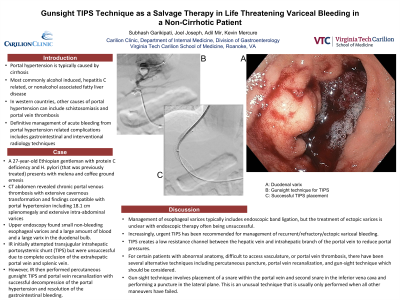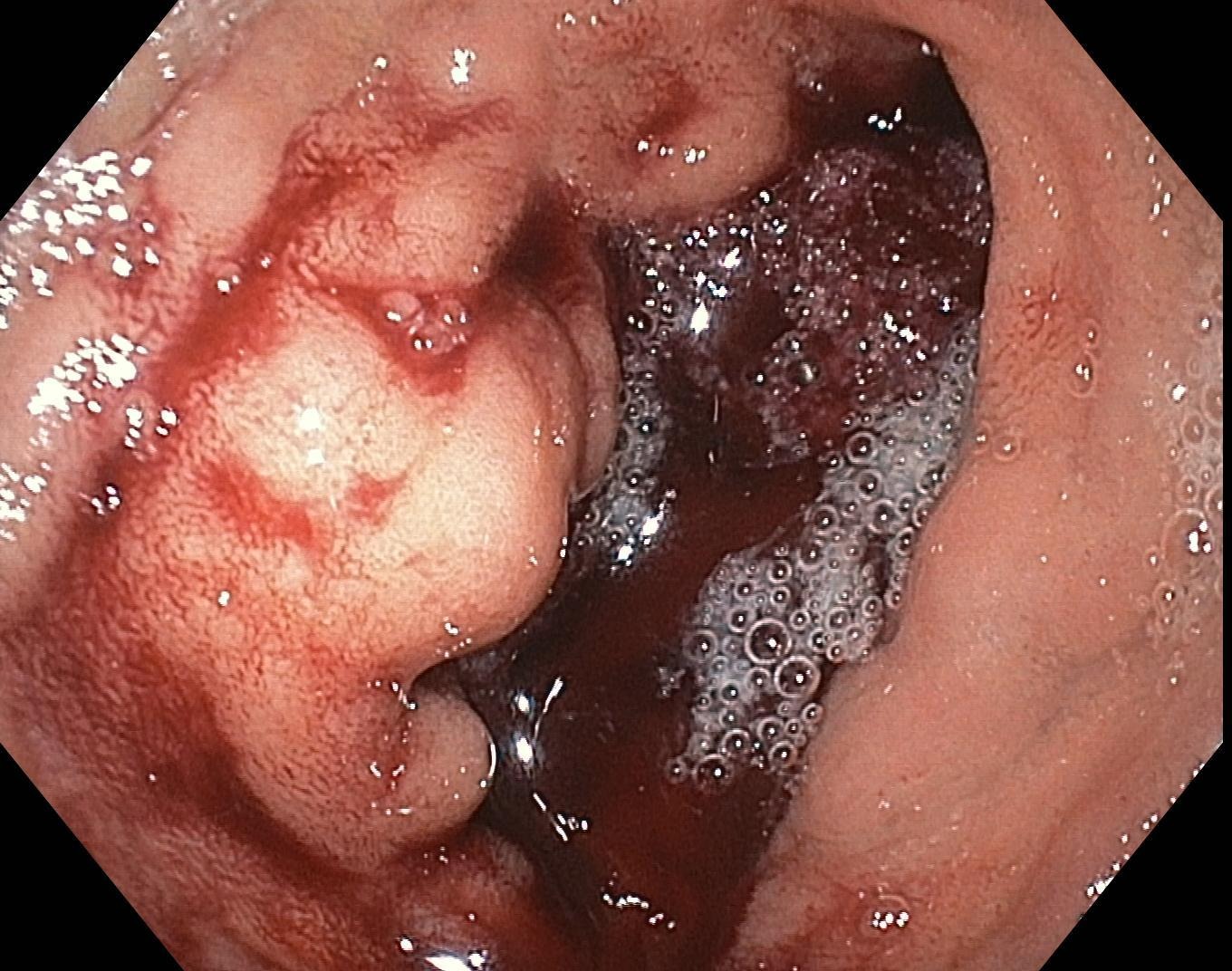Monday Poster Session
Category: GI Bleeding
P2065 - Gunsight TIPS Technique as Salvage Therapy in Life Threatening Variceal Bleeding in a Non-Cirrhotic Patient
Monday, October 23, 2023
10:30 AM - 4:15 PM PT
Location: Exhibit Hall

Has Audio
- SG
Subhash Garikipati, MD
Carilion Clinic Virginia Tech
Roanoke, VA
Presenting Author(s)
Subhash Garikipati, MD1, Joel Joseph, MD2, Adil Mir, MD2, Kevin Mercure, MD2
1Carilion Clinic Virginia Tech, Roanoke, VA; 2Virginia Tech Carilion, Roanoke, VA
Introduction: In adult patients, portal hypertension is typically caused by cirrhosis, most commonly alcohol-induced, hepatitis C-related, or nonalcohol-associated fatty liver disease. However, in patients outside Western countries, common causes of portal hypertension can include schistosomiasis and portal vein thrombosis. Regardless, the definitive management of acute bleeding from portal hypertension-related complications is similar with possible gastrointestinal and interventional radiology (IR) techniques but long-term management should be based on the underlying etiology.
Case Description/Methods: A 27-year-old Ethiopian gentleman with a past medical history of protein C deficiency and H. pylori (that was previously treated) presented with melena and coffee ground emesis. CT abdomen revealed chronic portal venous thrombosis with extensive cavernous transformation and findings compatible with portal hypertension including 18.1 cm splenomegaly and extensive intra-abdominal varices. Upper endoscopy found small non-bleeding esophageal varices and a large amount of blood and a large varix in the duodenal bulb. IR initially attempted transjugular intrahepatic portosystemic shunt (TIPS) but was unsuccessful due to complete occlusion of the extrahepatic portal vein and splenic vein. However, IR then performed percutaneous gunsight TIPS and portal vein recanalization with successful decompression of the portal hypertension and resolution of the gastrointestinal bleeding.
Discussion: Management of esophageal varices typically includes endoscopic band ligation, but the treatment of ectopic varices is unclear with endoscopic therapy often being unsuccessful. Increasingly, urgent TIPS has been recommended for the management of recurrent/refractory/ectopic variceal bleeding. TIPS creates a low resistance channel between the hepatic vein and the intrahepatic branch of the portal vein to reduce portal pressures. For certain patients with abnormal anatomy, difficult-to-access vasculature, or portal vein thrombosis, there have been several alternative techniques including percutaneous puncture, portal vein recanalization, and gun-sight technique which should be considered. The gun-sight technique involves the placement of a snare within the portal vein and a second snare in the inferior vena cava and performing a puncture in the lateral plane. This is an unusual technique that is usually only performed when all other maneuvers have failed.

Disclosures:
Subhash Garikipati, MD1, Joel Joseph, MD2, Adil Mir, MD2, Kevin Mercure, MD2. P2065 - Gunsight TIPS Technique as Salvage Therapy in Life Threatening Variceal Bleeding in a Non-Cirrhotic Patient, ACG 2023 Annual Scientific Meeting Abstracts. Vancouver, BC, Canada: American College of Gastroenterology.
1Carilion Clinic Virginia Tech, Roanoke, VA; 2Virginia Tech Carilion, Roanoke, VA
Introduction: In adult patients, portal hypertension is typically caused by cirrhosis, most commonly alcohol-induced, hepatitis C-related, or nonalcohol-associated fatty liver disease. However, in patients outside Western countries, common causes of portal hypertension can include schistosomiasis and portal vein thrombosis. Regardless, the definitive management of acute bleeding from portal hypertension-related complications is similar with possible gastrointestinal and interventional radiology (IR) techniques but long-term management should be based on the underlying etiology.
Case Description/Methods: A 27-year-old Ethiopian gentleman with a past medical history of protein C deficiency and H. pylori (that was previously treated) presented with melena and coffee ground emesis. CT abdomen revealed chronic portal venous thrombosis with extensive cavernous transformation and findings compatible with portal hypertension including 18.1 cm splenomegaly and extensive intra-abdominal varices. Upper endoscopy found small non-bleeding esophageal varices and a large amount of blood and a large varix in the duodenal bulb. IR initially attempted transjugular intrahepatic portosystemic shunt (TIPS) but was unsuccessful due to complete occlusion of the extrahepatic portal vein and splenic vein. However, IR then performed percutaneous gunsight TIPS and portal vein recanalization with successful decompression of the portal hypertension and resolution of the gastrointestinal bleeding.
Discussion: Management of esophageal varices typically includes endoscopic band ligation, but the treatment of ectopic varices is unclear with endoscopic therapy often being unsuccessful. Increasingly, urgent TIPS has been recommended for the management of recurrent/refractory/ectopic variceal bleeding. TIPS creates a low resistance channel between the hepatic vein and the intrahepatic branch of the portal vein to reduce portal pressures. For certain patients with abnormal anatomy, difficult-to-access vasculature, or portal vein thrombosis, there have been several alternative techniques including percutaneous puncture, portal vein recanalization, and gun-sight technique which should be considered. The gun-sight technique involves the placement of a snare within the portal vein and a second snare in the inferior vena cava and performing a puncture in the lateral plane. This is an unusual technique that is usually only performed when all other maneuvers have failed.

Figure: Duodenal varix with pooling of blood in the duodenal bulb
Disclosures:
Subhash Garikipati indicated no relevant financial relationships.
Joel Joseph indicated no relevant financial relationships.
Adil Mir indicated no relevant financial relationships.
Kevin Mercure indicated no relevant financial relationships.
Subhash Garikipati, MD1, Joel Joseph, MD2, Adil Mir, MD2, Kevin Mercure, MD2. P2065 - Gunsight TIPS Technique as Salvage Therapy in Life Threatening Variceal Bleeding in a Non-Cirrhotic Patient, ACG 2023 Annual Scientific Meeting Abstracts. Vancouver, BC, Canada: American College of Gastroenterology.
